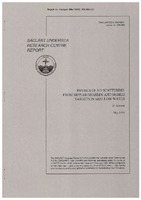| dc.contributor.author | Schmidt, Henrik | |
| dc.date.accessioned | 2018-10-11T14:08:46Z | |
| dc.date.available | 2018-10-11T14:08:46Z | |
| dc.date.issued | 1998/05 | |
| dc.identifier | 12134 | |
| dc.identifier.govdoc | SR-289 | |
| dc.identifier.uri | http://hdl.handle.net/20.500.12489/513 | |
| dc.description.abstract | The new OASES-3D code developed at MIT is used to investigate the spatial and temporal characteristics of reverberation from rippled seabeds insonified by narrow beam sonars such as the TOPAS parametric source. It is shown that the highly polarized - close to monochromatic - spectral characteristics of ripple fields is associated with a reverberation environment which is highly sensitive to both frequency and insonification aspect relative to the ripples. The study suggests that significant gains in detection performance for buried objects can be achieved by band-limiting the processing to frequencies below an environmentally dependent "cut-off" frequency. The study also confirms theoretically the intuitive advantage of insonifying the seabed along the ripple direction to reduce monostatic reverberation. | |
| dc.format | vi, 29 p. : ill. ; 15 fig. | |
| dc.language | English | |
| dc.publisher | NATO. SACLANTCEN | |
| dc.relation.ispartofseries | ADB247074L | |
| dc.subject | Buried objects detection | |
| dc.subject | Mine burial and bottom conditions | |
| dc.subject | Shallow water | |
| dc.subject | Acoustic reverberation | |
| dc.subject | Acoustic scattering by elastic structures | |
| dc.title | Physics of 3-D scattering from rippled seabeds and buried targets in shallow water | |
| dc.type | Scientific Report (SR) | |
